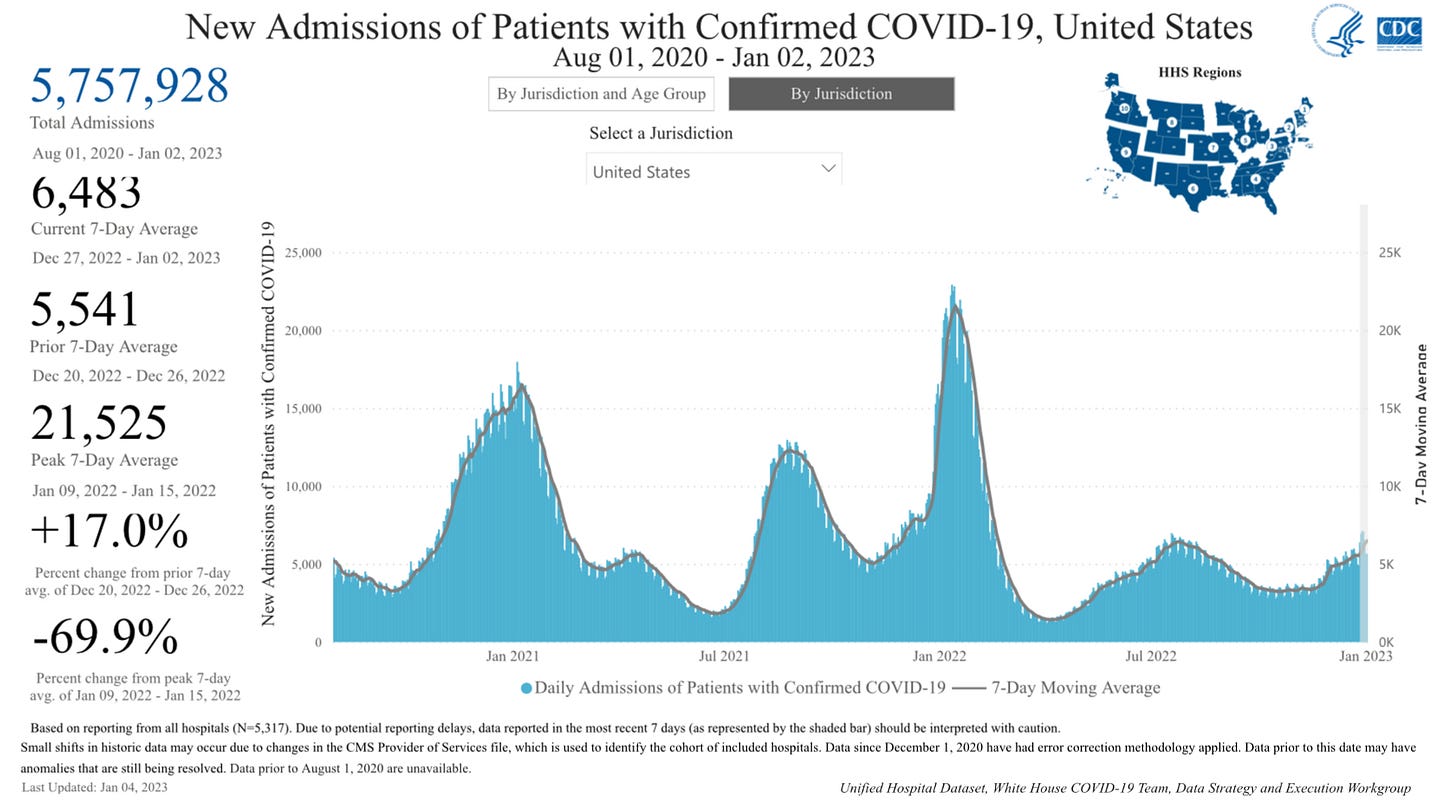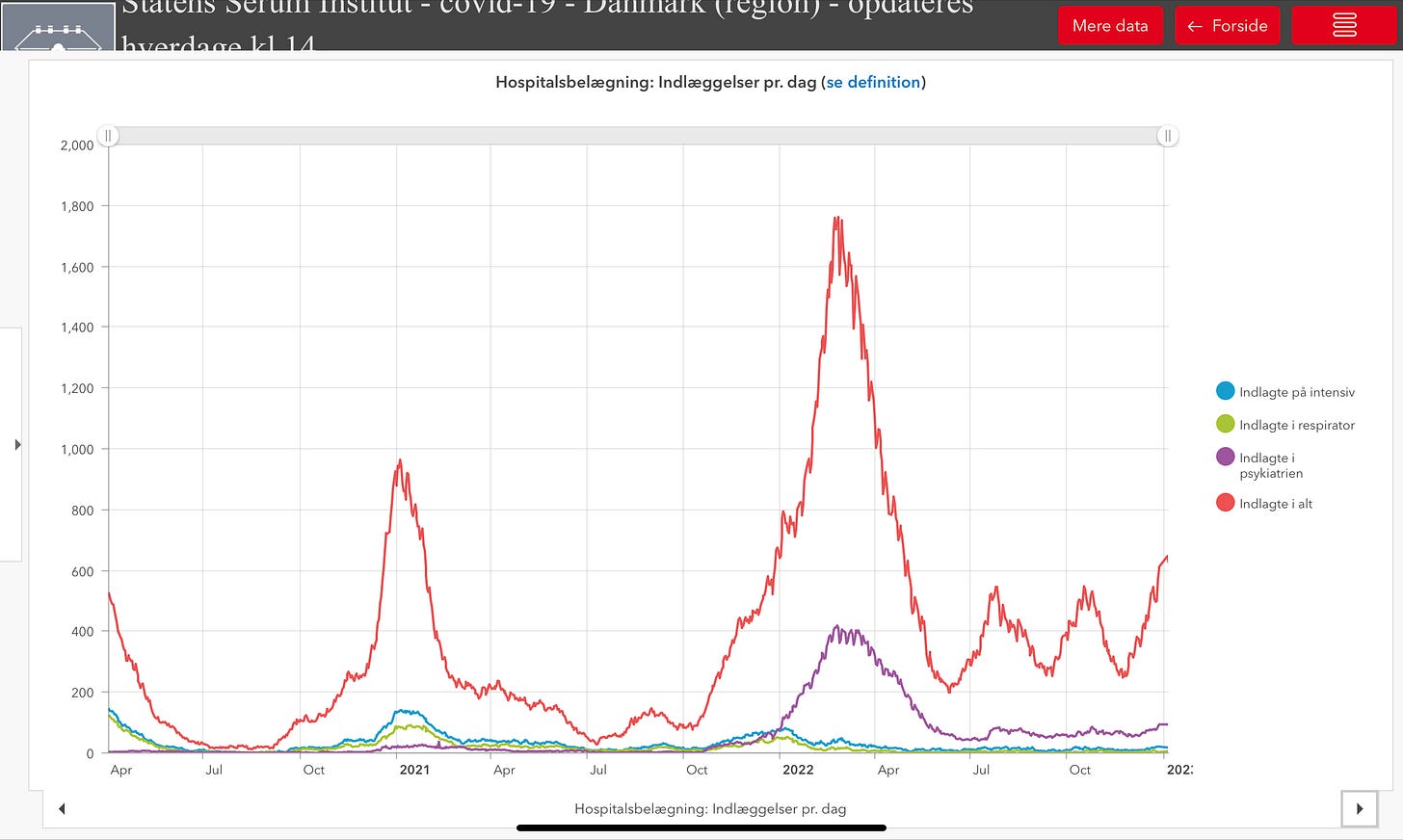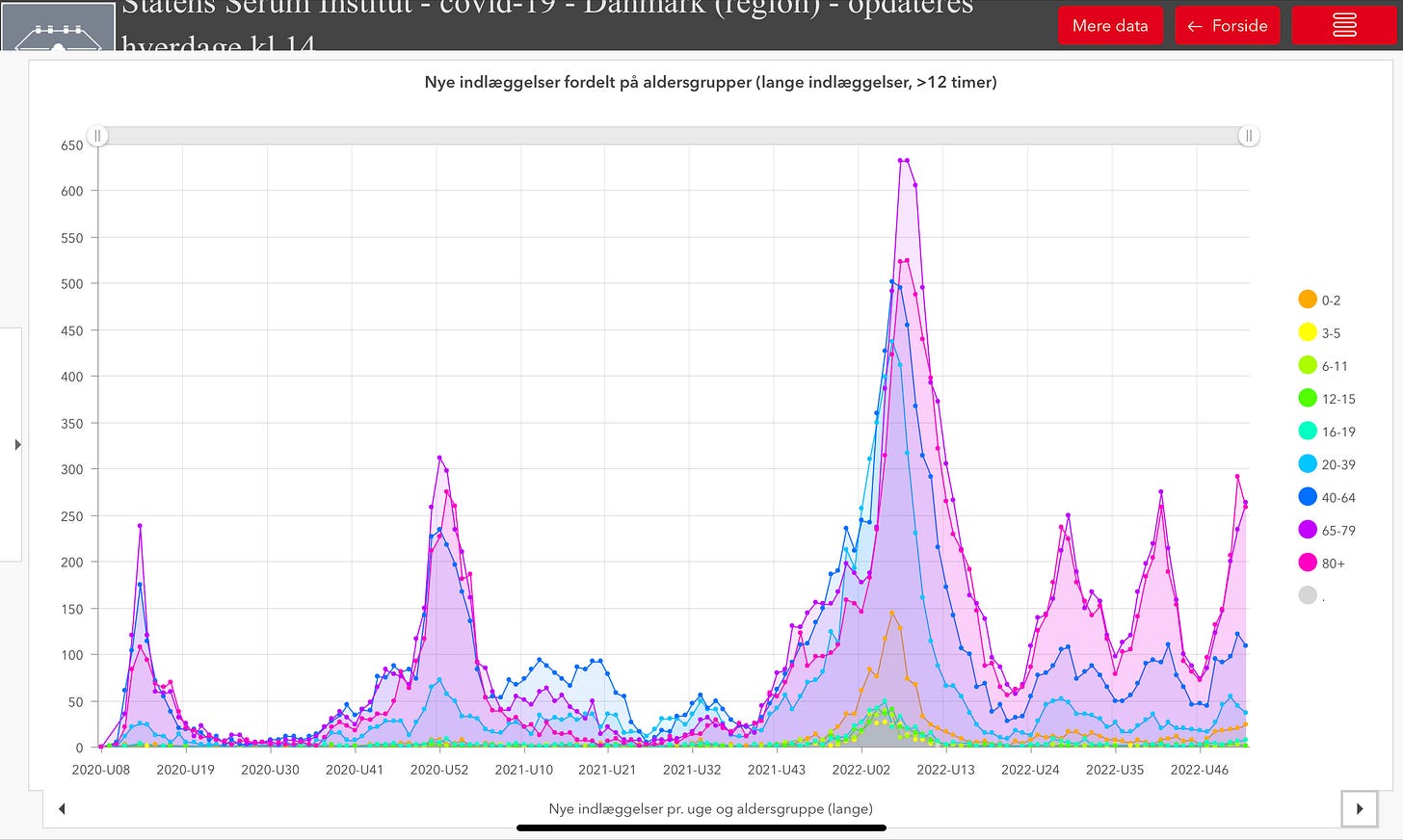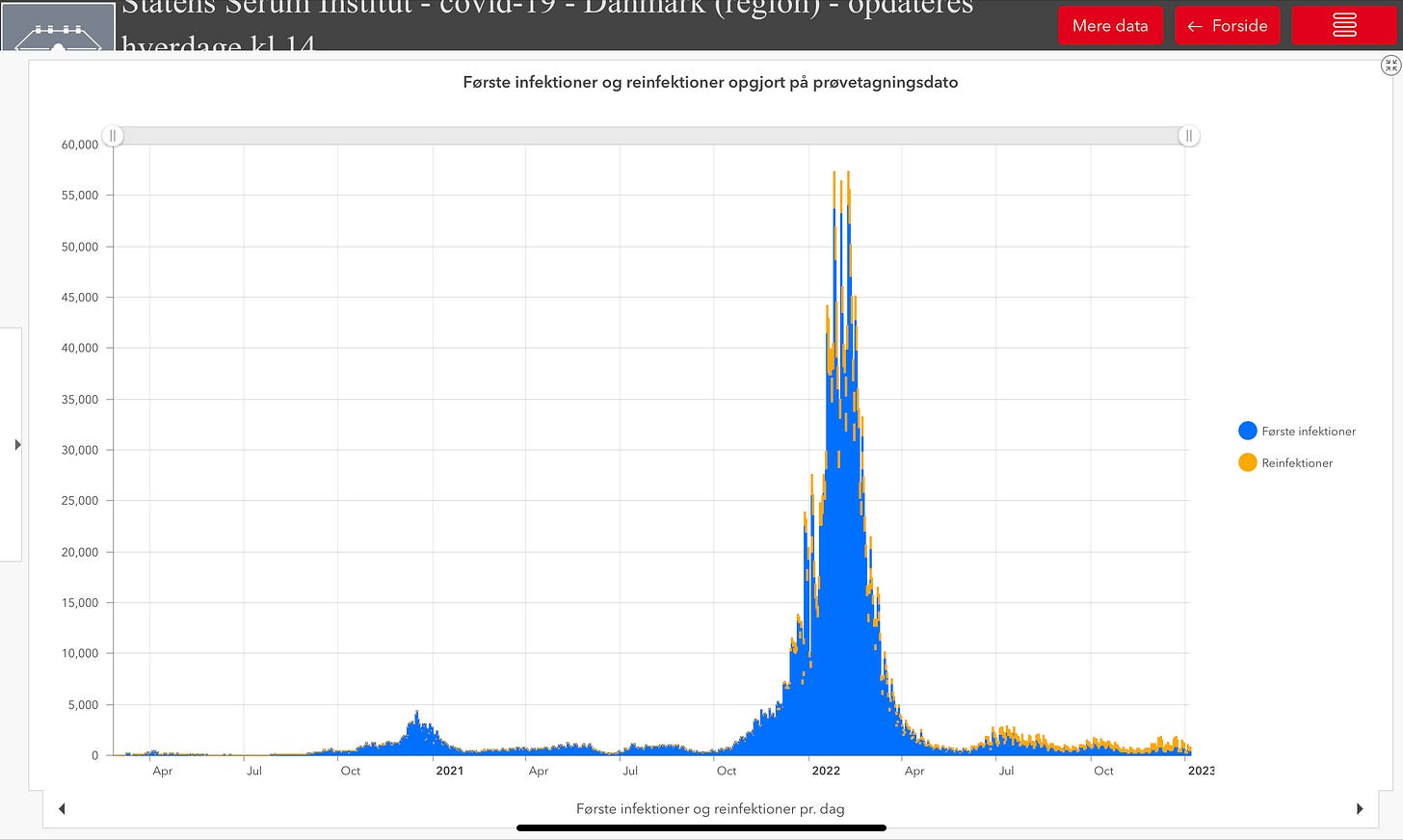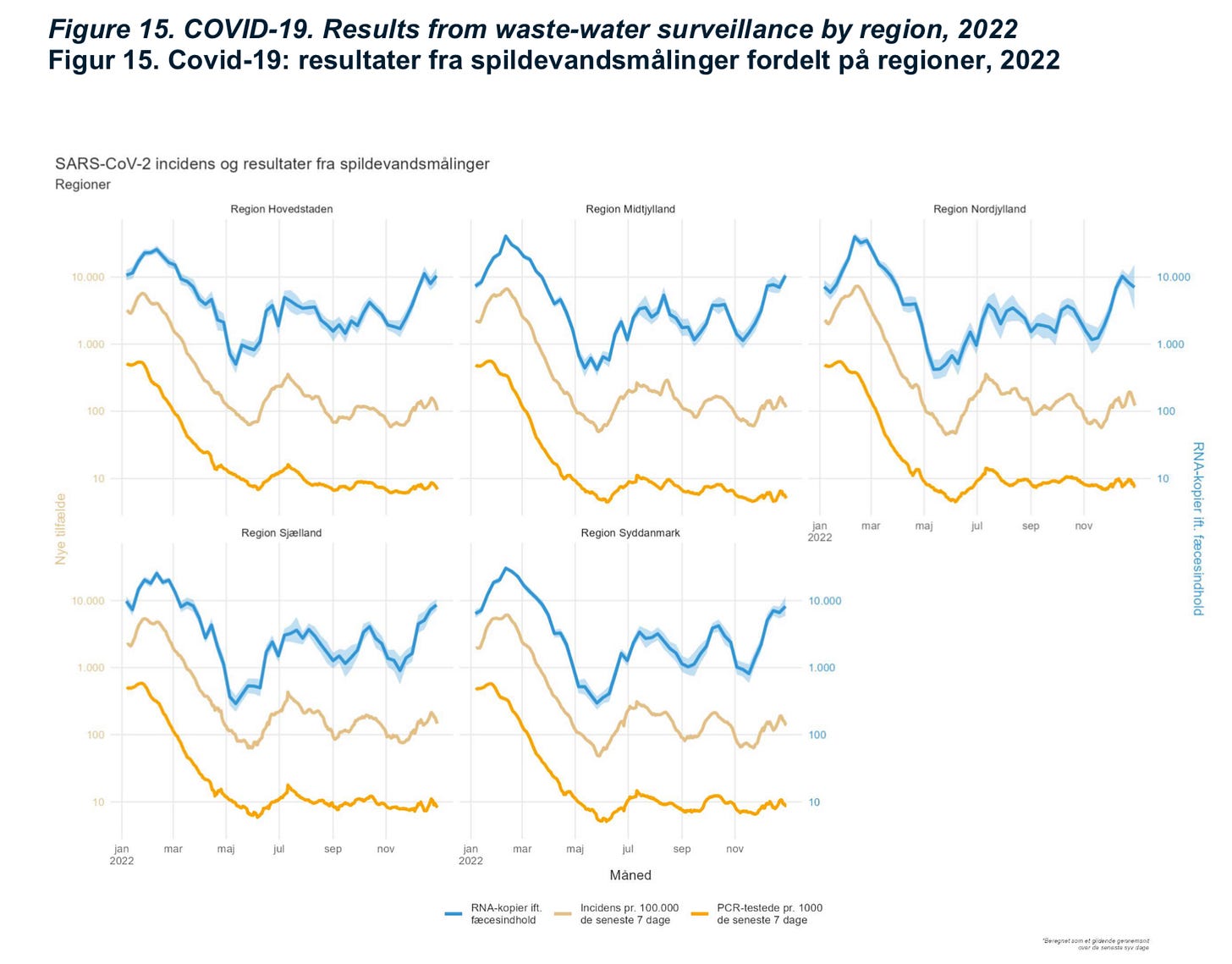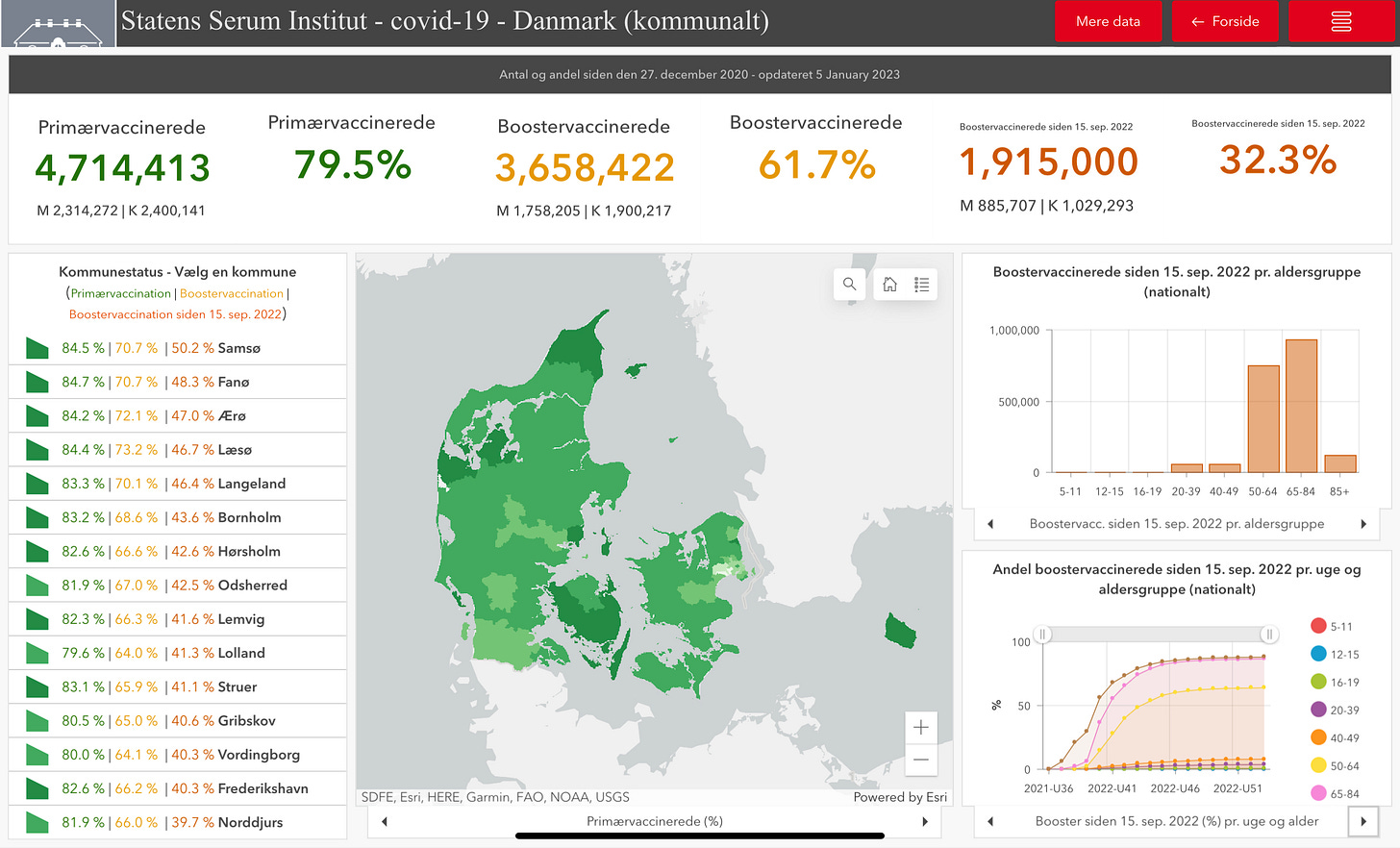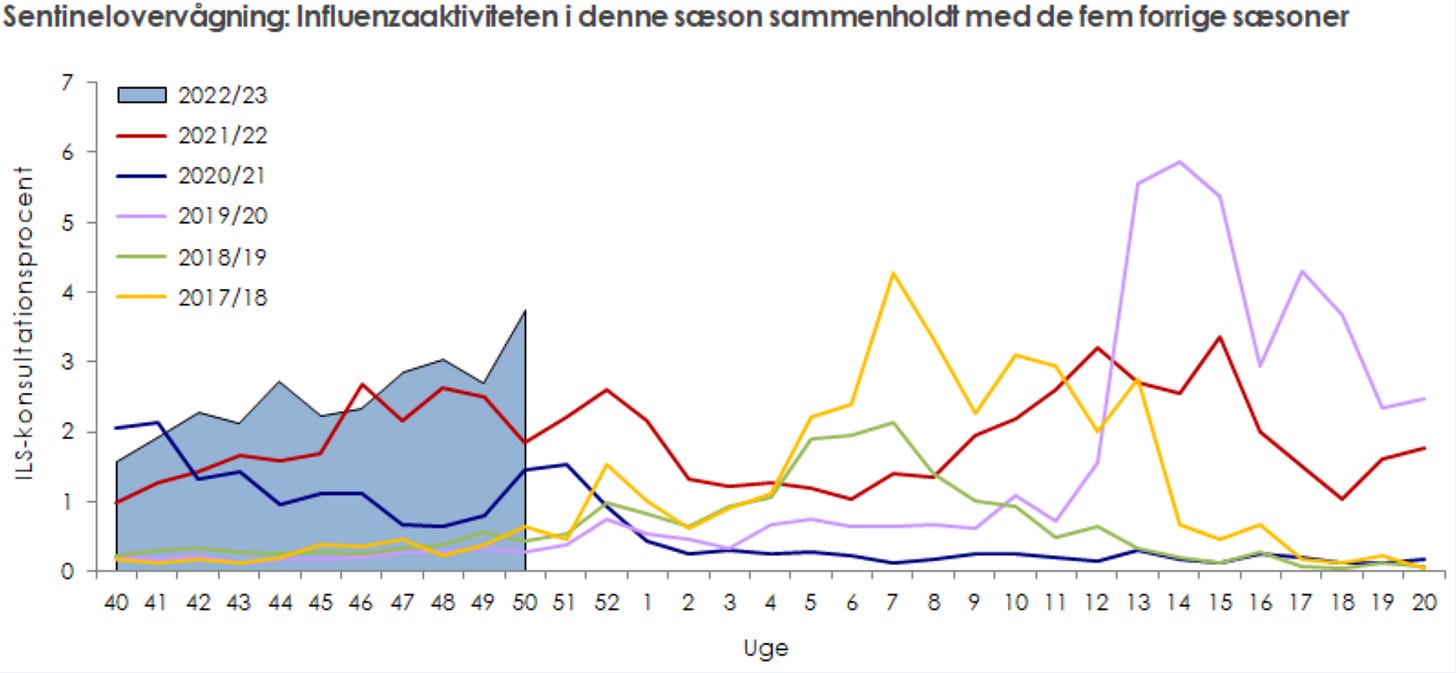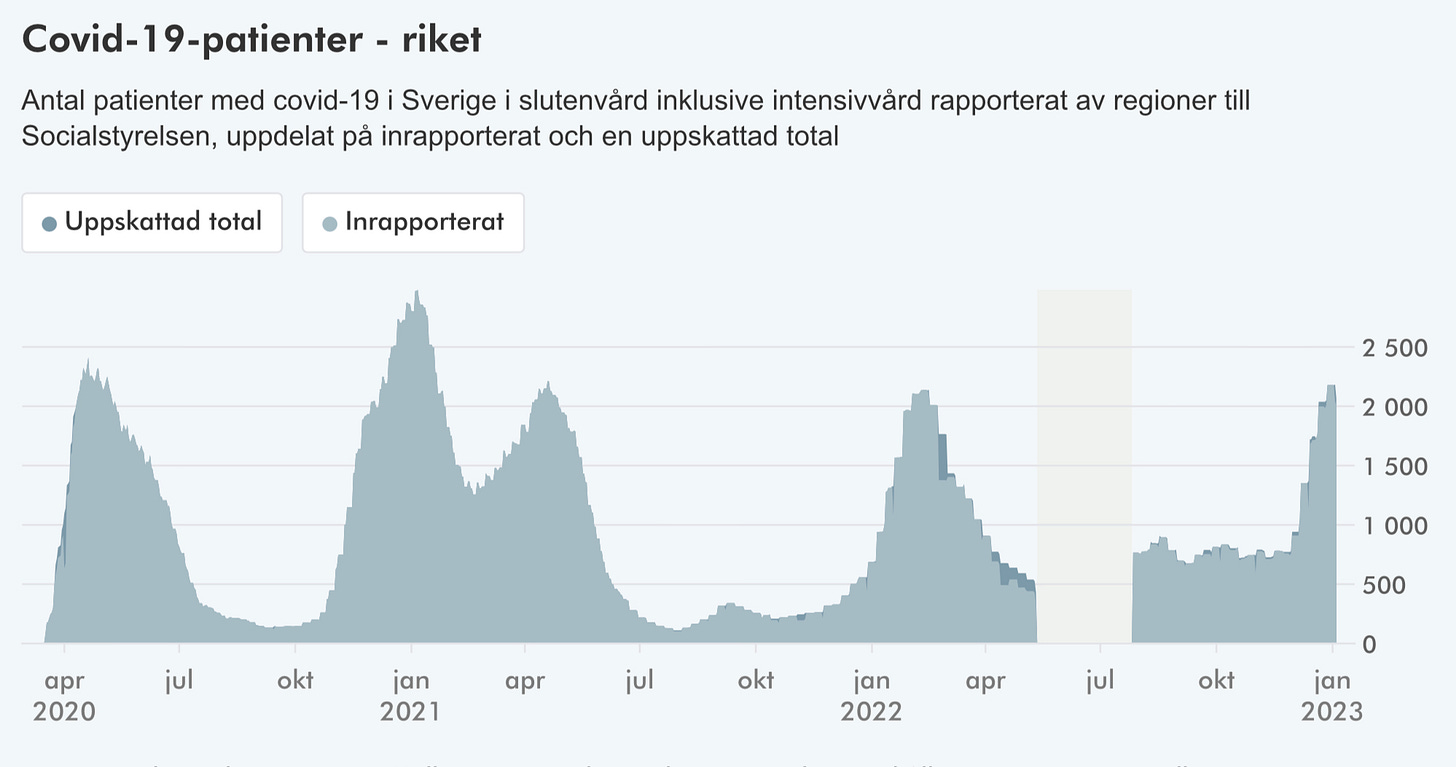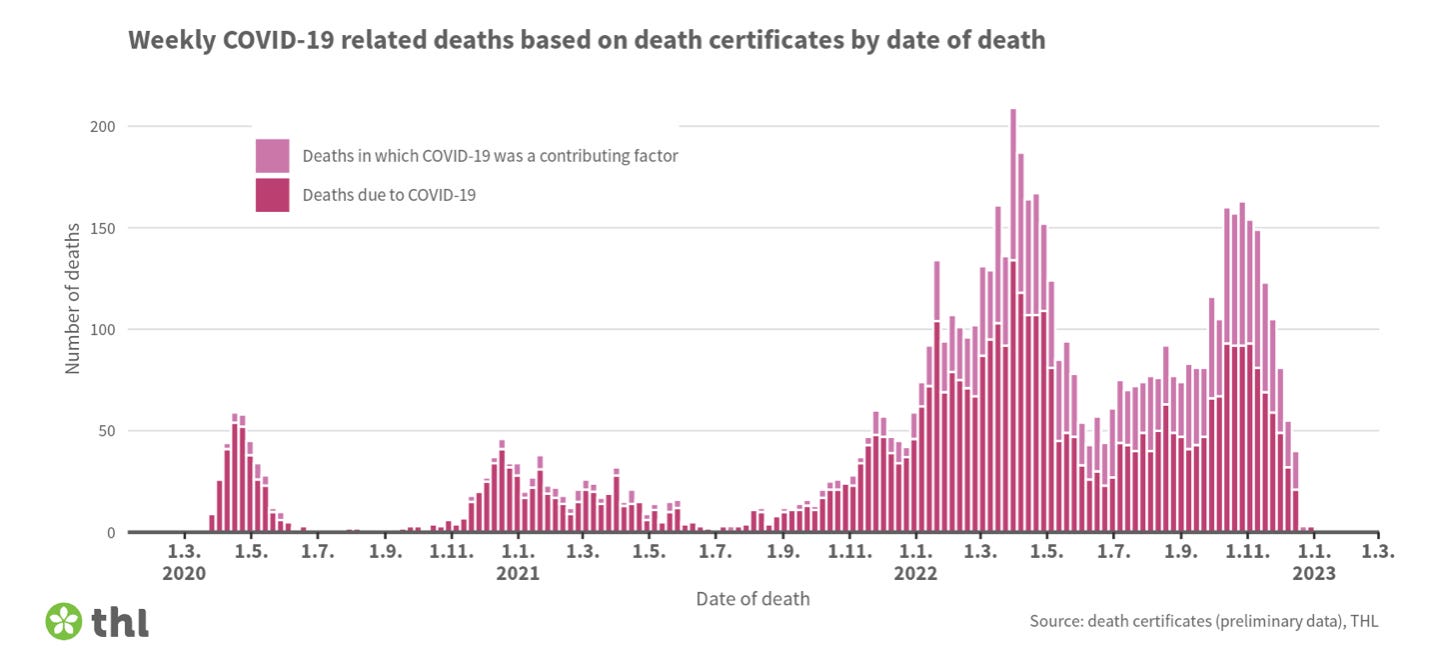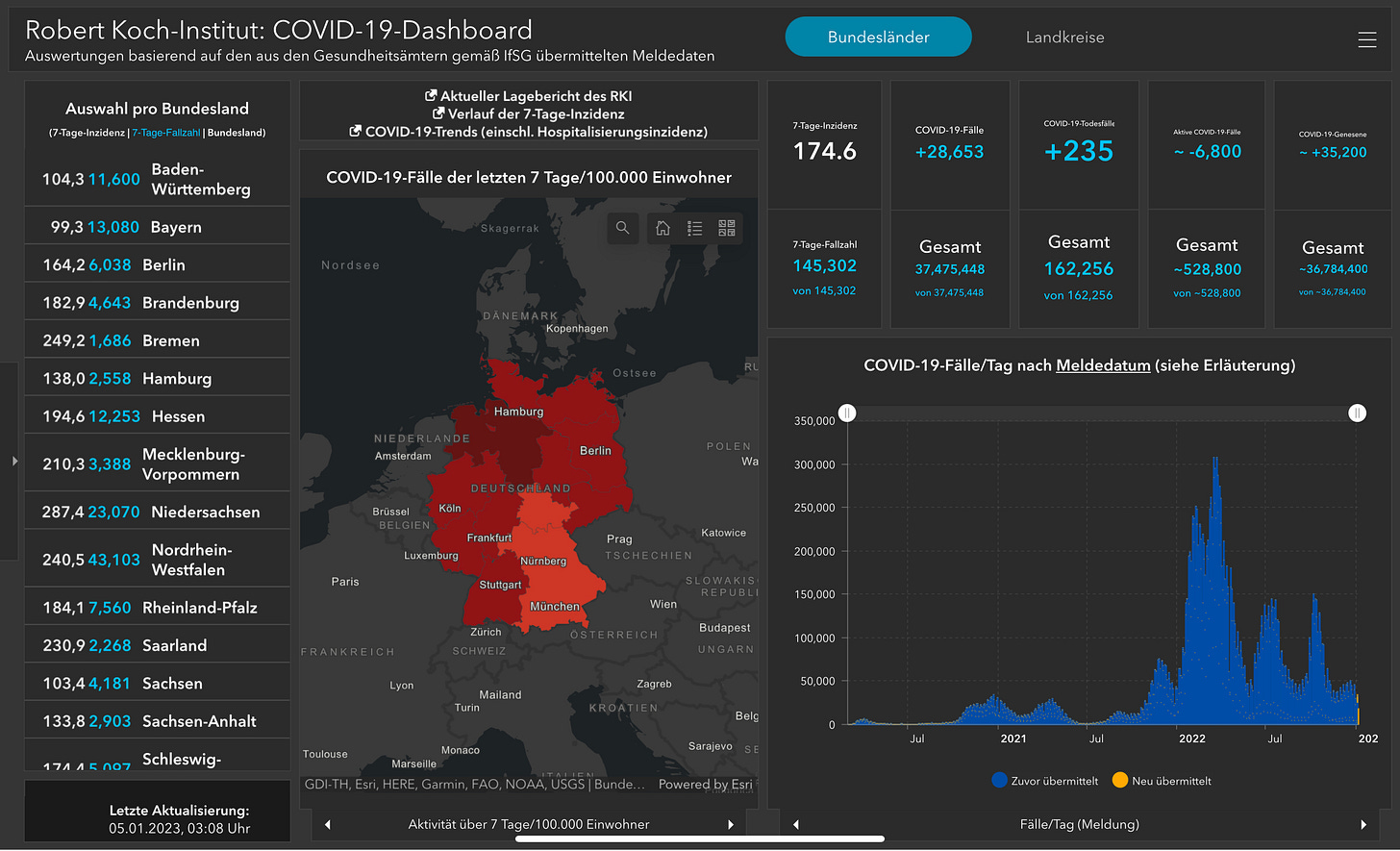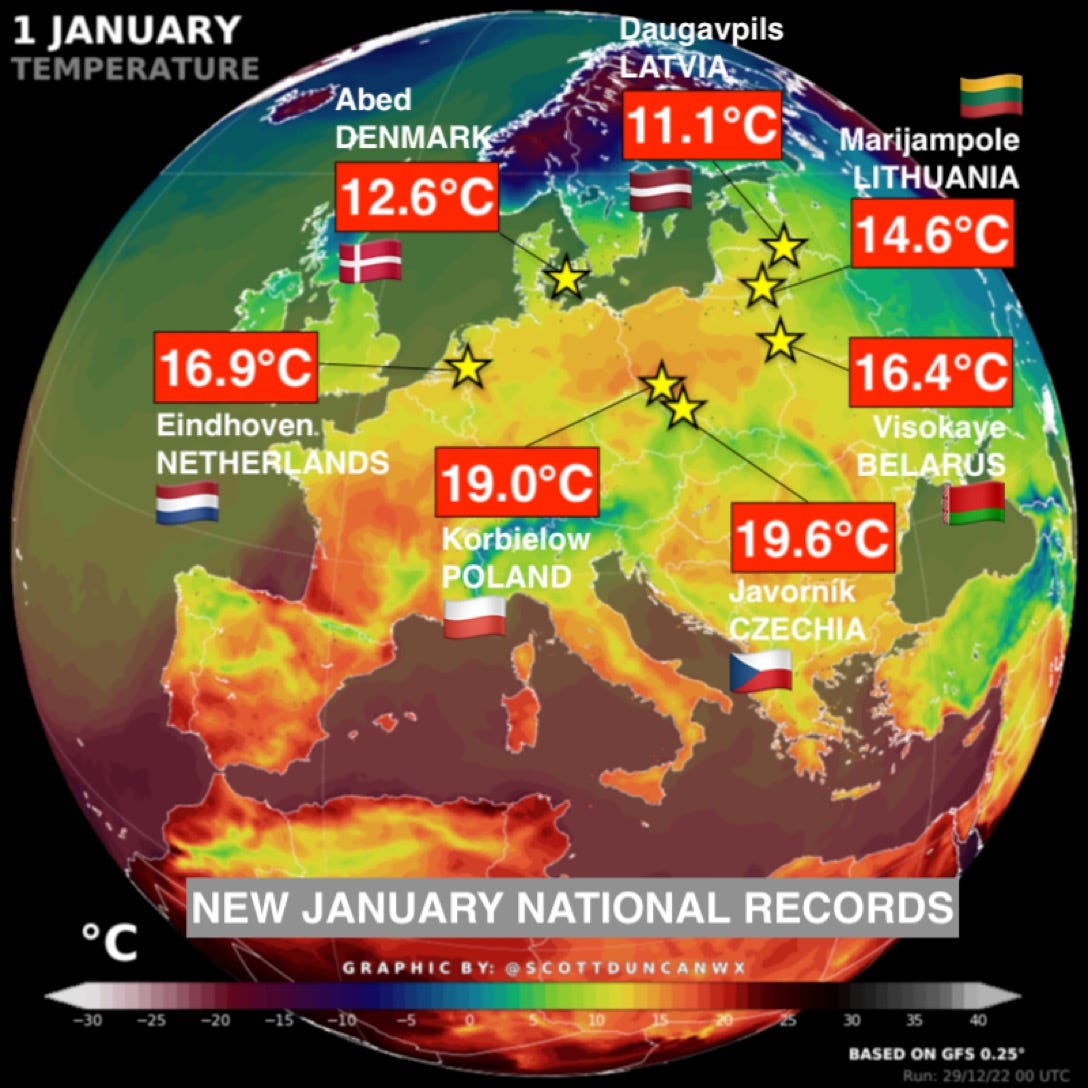The Evening Report - Jan 5
A new variant rears its head. Pandemic deaths soar in Denmark and Sweden.
🦠Pandemic🦠
🚨New Variant Alert🚨
The World Health Organization is raising alarm about the emergence of the most contagious coronavirus sub-variant yet, XBB.1.5.
Infectious Disease Epidemiologist, and WHO COVID Technical Lead, Maria Van Kerkhove:
“So this is a sun-lineage of XBB, which is a recombinant of two BA.2 sun-lineages. XBB.1.5 has been detected in 29 countries so far. There may be more. As sequencing becomes less and less available at a global level, it becomes more difficult to track these variants of Omicron. So it is part of Omicron. It is the most transmissible sub-variant that has been detected yet. The reasons for this are the mutations within this recombinant, this sub-variant of Omicron, allowing the virus to adhere to the cell and replicate easily. And we are concerned about its growth advantage. In particular, in some countries in Europe, and in the U.S, in North America, particularly the north-east part of the United States XBB.1.5 has rapidly replaced other circulating variants. Our concern is how transmissible it is. It does have immune escape like we have seen with XBB. The more this virus circulates, the more opportunities it will have to change. We do expect further waves of infection around the world, but that doesn’t have to translate into further waves of death because our counter-measures continue to work.”
Kerkhove says the WHO Technical Advisory Group is busy working on a risk assessment for this new variant. She hopes it will be published in the next few days. But, as of yet, Kerkhove says there is no clear answer yet on whether this new variant causes more severe infections or its overall clinical picture.
“We also don’t have any indication that severity has changed, but that is something we are watching very closely.”
To that end, she says, the WHO is monitoring global hospitalizations very closely.
In the United States, where XBB.1.5 is spreading very quickly, hospitalizations are rising.
🇨🇳
The pandemic situation in China has exploded since COVID restrictions were removed after an unprecedented public backlash against the Chinese government's ‘COVID Zero’ approach.
University of Copenhagen Global Health Professor Flemming Konradsen spoke to DR:
“The reports coming from sources in China indicate that the crematoria are under heavy strain. The low vaccination rates of the elderly and chronically ill, as well as the type of vaccine they have received, will increase the risk of many deaths.”
However, the pandemic situation in China is extremely hard to assess as it, like elsewhere around the world, has virtually stopped testing. On top of that, the communist government’s iron fist on not publishing any reliable information is also helping to make the situation more murky.
For example, China's Center for the Prevention of Infection claims just 14 people have died due to the coronavirus since December 1.
“We have received some official figures which are grossly misleading. The only thing we know for sure is that the number of infected people has exploded, and there is definitely a lot of pressure on [China’s] health system.”
The British analytical institute Airfinity is estimating that around 18.1 million people in China have been infected since December 1. And of those, more than 100,000 have died. The firm is forecasting the infection wave in China to peak sometime next week with 3.7 million infections and 25,000 pandemic deaths per day. The death toll in China from this wave alone will reach 1.7 million people by April, according to the firm.
“It is not an unrealistic figure, but the models that come from analysis institutes and universities are fraught with incredibly great uncertainty. No one knows whether it will be 10,000, 20,000 or 30,000 deaths per day when it peaks. If the Chinese authorities would share data, the guesswork would be reduced.”
The World Health Organization is also demanding that China be more transparent and share pandemic information.
Director-General Tedros Adhanom Ghebreyesus says his team has met with Chinese officials.
“The WHO needs more detailed information about the seriousness of the infection, its spread, hospitalizations, and the demand for intensive care beds. My team met with China representatives virtually to discuss the current surge in coronavirus cases. We again stressed the importance of transparency and regular sharing of data to formulate accurate risk assessments and to inform effective response.”
While chastising Chinese officials for a lack of data transparency, the WHO says the Chinese CDC seems to show a predominance of the BA.5.2 and BF.7 COVID variants.
🇪🇺/ 🇨🇳
Travelers from China could soon face restrictions on entering the European Union. The EU Integrated Political Crisis Response Council met on Wednesday and recommended that travelers from China should have to have a negative COVID test no more than 48 hours old in order to enter the European Union. This could come into force as of January 8, the same day China removes travel restrictions on its citizens, allowing them to resume international travel.
The EU crisis council also recommended that all passengers traveling by plane from, or through China, to Europe should wear a mask onboard their flights. Passengers going to and coming from China will also be reminded about best hygiene practices and health measures to prevent infection spread. It also wants European Union countries to implement random COVID testing on passengers arriving from China and ensure that every positive test is sequenced. This could include wastewater surveillance testing on all international flights arriving from China and at airports that are ports of entry.
The council will meet again in mid-January to re-assess the situation and its recommendations.
🇸🇪/ 🇨🇳
Sweden will require travelers from China to have a negative COVID test in hand in order to enter the country. The test can be a rapid test or a PCR test, but it must be a testing device approved for use in the European Union. The result must be no more than 48 hours old and be in either Swedish or English to be considered valid. The mandate applies to all travelers from China 12 years old and older, regardless of vaccination status.
The certificate must also note the testing date and time as well as the name and date of birth of the person being tested. It must also have the name and contact details of the laboratory processing the test itself.
The testing requirement comes into force on January 7, and is set to expire, unless extended, on the 29th.
Forssmed said in a press release that it is a fluid situation at the moment.
“The government has given the Public Health Agency the task of analyzing the situation in China and the consequences for Sweden and coming up with proposals for measures, including travel restrictions. We are prepared for different scenarios and have an ongoing dialogue with the Public Health Agency.”
The United States, Canada, France, Spain, and Italy, are among countries that have already placed a negative COVID test restriction on travelers from China.
🇧🇪/ 🇨🇳
Belgium is also already taking steps. The Belgian government has announced it will, beginning this week, do coronavirus wastewater testing on all flights coming from China and landing in the country. It will also request that all travelers coming from China take a voluntary COVID test if they develop symptoms within seven days of arrival.
🇩🇰
A Danish Emergency Medicines Specialist working in Sonderjylland says the coronavirus has made its return “in its most dangerous form.” He says that on New Years Eve several patients were admitted suffering from severe COVID pneumonia who were struggling to breathe “a condition that I have hardly seen in the last year.”
As for why, he says that the BQ.1.1 variant may be to blame.
-
The Danish Statens Serum Institute is warning that the BQ.1.1 variant is one of the most immune evasive yet, meaning it has a better ability of slipping around vaccine or prior infection-induced antibodies to infect people. Here in Denmark, despite soaring vaccination rates, booster dose uptake, and population level protection due to having had an infection, COVID cases are rising.
SSI Professional Director Søren Alexandersen spoke to TV2:
“It is that [BQ.1.1] and a number of other sub-variants, for example B.Q.1.1.20, that is helping to drive infection spread, because they are more immune evasive.”
The SSI’s last variant update, said that the BQ.1.1 strain now makes up 49% of all infections, meaning by now it is likely the dominant coronavirus variant in Denmark.
The institute continues to stress that there is no evidence yet showing that the BQ.1.1 variant causes any more severe of an infection or an increased likelihood of being hospitalized.
Alexander says while the new variant is driving infection numbers, it is probably not the reason why excess mortality rates among seniors 85 years old and older have significantly increased.
“We cannot rule it out, but we can say that when we look at people who have received a booster with the variant-specific vaccines, the vaccines seem to provide good protection against hospitalization and serious illness also when it applies to the BQ.1.1 variant.”
The virus strain is a sub-variant of BA.5, and studies, like one published recently in Nature Medicine, showed vaccine-induced antibody protection against infection from BQ.1.1 was four times lower than the parent BA.5 strain.
-
On the variant front, the share of infections related to the BQ.1.1 variant actually declined in the last week of the year, making up 38% of sequenced positive test results. The share of BA.2.75 variant infections jumped from 19.37% to 28.26% of all infections week over week. There were 17 confirmed infections (1.51%) last week involving the new XBB.1.5 variant in Denmark.
-
However, the Statens Serum Institute is continuing to emphasize that COVID booster dose vaccinations, especially those using variant specific bivalent vaccine doses, are very effective at reducing the risk of severe infection resulting in hospitalization.
In a new study, the agency found those who recorded a bivalent booster dose during the fall of 2022 were 73% better protected against severe infections than those with just one booster dose.
Senior Physician and Manager Bolette Søborg:
“We have studied the effect of bivalent booster vaccines on hospitalization, and we can see that they have a good effect. This applies regardless of which vaccine you have received and how old you are.”
-
COVID cases dropped over the holidays, according to the latest weekly update from the Statens Serum Institute. Infection numbers continue to be an unreliable statistic and especially so over the Christmas and New Year holidays due to a drop in already very low amounts of testing. I expect the weekly updates to have a more accurate handle on things in the weeks ahead as life returns to normal, so I won’t dwell on case numbers too much this time.
The institute notes that despite overall case numbers declining, infections among vulnerable seniors 80 years old and older “significantly increased” last week.
The COVID incidence rate fell from 152 per 100,000 people to 115 from week 51 to week 52. The positivity percentage also inched down from 21.4% to 19.5%.
Region Sjælland had the highest incidence rate (152) and Region Hovedstaden had the lowest (99). Region Midtjylland had the highest positivity percentage with 25.2%.
-
COVID hospitalizations (626) dropped day to day (-21) but still remains at the highest level since the spring of last year. The number of severe infection cases in an ICU (18) and of those, the number on a ventilator (6) are both unchanged.
As far as weekly hospital statistics, the SSI says there was a slight decrease in hospitalizations last week, with 801 new admissions. This compares to 826 the week before. As it has been ally of last year, seniors 70 to 89 years old continue to make up the largest proportion of new hospital admissions.
The SSI says the ongoing booster dose campaign is paying dividends. In the last week of the year hospitalizations due to a COVID infection among the booster dose target group was 26 per 100,000 people. The hospitalization rate among the same age group who had not had a 4th dose was 36 per 100,000. The difference was more stark among very elderly seniors over the age of 85, with a hospitalization rate of 119 among those with a 2nd booster shot, compared to 224 for those unvaccinated or not boosted.
-
Pandemic deaths in Denmark have “increased significantly” according to the Statens Serum Institute, with excess mortality rates now “above normal.” In the last day, another 12 coronavirus deaths were reported.
There were 94 pandemic related deaths last week.
The SSI says fatalities are highest among those 75 years old and older. It says the spread of influenza and other respiratory viruses may be a complicating factor.
Dr. Lasse Vestergaard:
“It is a steeper curve than we normally see, and it surprises us a little. We usually see a higher mortality in the winter months, but the figures show that right now there is a higher mortality than there usually is at this time of the year.”
Vestergaard says unlike previous pandemic winters, there is more than just coronavirus infections spreading around the country and that could be contributing to the rise in COVID deaths.
“This is probably due to the fact that there are more respiratory infections in circulation at the moment. In addition to COVID, we have had a high level of RS virus since the autumn, and the flu infection has also been increasing in recent weeks, especially among the elderly. Those things together can contribute to increased mortality.”
-
Denmark is reporting 870 new infections (underreported), including 405 reinfections, in the last day. The SSI warns that reduced testing over the holidays (-19%) may be skewing the pandemic picture.
With 7,128 PCR tests taken yesterday, that equals a positivity percentage of 12.20%.
-
Nationally, coronavirus activity increased slightly in the latest COVID wastewater testing. There were also small increased in four of the five Danish regions, with only Region Nordjylland registering a small decline in virus activity. Region Sjælland is seeing the sharpest increase in virus activity according to wastewater surveillance.
-
On the vaccination front, 32.3% of the total population has received a 2nd booster dose. Of those in the target group of people 50 years old and older, the uptake for a 4th dose is 75%. Among seniors 85 years old and older, it is 88%. And it is 89% among vulnerable seniors in care.
-
The annual influenza epidemic has officially returned in Denmark and flu infections are now “sharply increasing” according to the Statens Serum Institute. It is urging everyone who is eligible to get a flu shot to minimize the risk of a double epidemic of influenza and coronavirus.
The SSI says influenza cases have doubled every week for the past four weeks. Between week 47 and week 50 at the end of 2022, the number of weekly flu infections rose from 64 to 593. And influenza cases more than doubled in the last week of 2022.
The agency says influenza is spreading fast across the entire country and hospitalization numbers are also mounting.
Dr. Lasse Vestergaard
“We are seeing a sharp increase right now, but we are still within the normal range. Influenza infections usually peak in February-March, and it is still too early to say how serious a season we will have this year.”
So far, the H1N1 and H3N2 strains of the influenza type A virus are dominating, along with the Victoria subtype of influenza type B.
The concern is that with both an influenza and coronavirus epidemic that seniors and other high-risk populations will be even more vulnerable. It could also mean that hospitals could once again be under the gun.
“But, a high adherence to both COVID and influenza vaccinations in Denmark, especially among older people, reduces the risk that we will see many seriously ill patients requiring hospitalization.”
Across Europe, 27 countries are now reporting widespread influenza infection outbreaks.
🇸🇪
Sweden has added 8,494 new infections (wildly underreported) and suffered 315 more corona deaths since its last update. Total pandemic deaths in Sverige now exceed 22,000, more than Denmark, Norway, and Finland combined.
That said, the gap between Sweden and the rest of the Nordics used to be quite significant but sadly the combined death toll among Sweden’s Scandinavian neighbours has gotten a lot closer.
-
COVID hospitalizations (2,006) are down (-173) and intensive care numbers (37) have also declined (-11).
-
Sweden is still in the throes of a triple-demic as the Swedish Public Health Agency warns that COVID, influenza, and RS virus infections continue to be widespread. The agency is urging people who are sick or who have symptoms to stay home.
State Epidemiologist Anders Lindblom:
“In the next week, many people will return to their workplaces after the holiday and schools will start again, and therefore it is important that we all help each other now. Those who are sick with symptoms of a respiratory infection should stay at home and avoid close contact with others.”
The health agency also warns with so many respiratory infections circulating, the pressure on hospitals across Sweden is significant.
On the COVID front, there were 35 new pandemic-related ICU admissions last week, but the health agency cautions that number is expected to rise with follow-up reporting. There has been an average of 48 coronavirus-related hospitalizations over each of the last three weeks.
The number of pandemic deaths in Sweden climbed significantly at the end of 2022. There were 255 COVID fatalities in the 2nd last week of the year. A pretty major increase from the still very high average of 124 deaths in each of the three prior weeks.
It says there has been no decline yet in RS virus activity, while influenza infections rose by 20% last week to finish off 2022. The agency says the flu infection curve remains “strong”. The rising level of influenza activity is also translating into increasing numbers of hospitalizations and intensive care admissions. Last week, there were 43 new flu-related ICU admissions.
“Due to the Christmas and New Year holidays, there may be some lag in data being reported, and the number of confirmed cases may be affected by temporarily changing patterns of those in care and testing. If the number of reported cases is too low, it means that more people in society are sick than the statistics show.”
🇫🇮
Finland registered 8,192 new infections and another 150 virus deaths since its last update.
-
The Finnish Institute for Health says it hasn’t yet detected any cases involving the new XBB.1.5 variant. It says with the variant spreading quickly in the United States and due to the situation in China, it is closely monitoring pandemic developments. It is also assessing whether it needs to enhance its own surveillance measures to better track coronavirus mutations.
Currently, it sequences about 350 to 400 positive test results every week.
Leading Expert Jari Jalava:
“The XBB.1.5 sub-variant is estimated to be extremely contagious, but it is not currently known if it causes a more severe infection than other Omicron variants.”
The institute says it believes the variant originated in the United States and has since been confirmed in the United Kingdom, India, Israel, and Trinidad-Tobago.
“New virus forms can spread quickly around the globe. During the corona pandemic, it has been seen that it is practically impossible to stop highly infectious virus variants at country borders. The best way to protect yourself from infection is to take the recommended COVID vaccinations. All the vaccines in use in Finland protect well against very severe infections.”
🇳🇴
The Norwegian Institute of Public Health hasn’t provided its weekly pandemic report since the week before Christmas.
🇩🇪
Germany recorded 28,653 new infections and suffered another 235 pandemic deaths day to day.
It also added 2,490 more COVID hospitalizations, while ICU numbers (1,350) eased (-40). As a percentage of all intensive care beds in the country, coronavirus patients are using 6.5%.
🇨🇦
The Public Health Agency of Canada hasn’t provided a COVID update since before Christmas. It was supposed to resume publishing statistics on the 3rd, but has not yet done so.
⚡️Energy Crisis⚡️
🇪🇺
Temperature records are being shattered across Europe in the first few days of this new year as climate change continues to make its presence felt. New Years Day temperatures were jaw-dropping.
While this emphasizes the massive threat we face with a changing climate and a warming earth, it has also, so far, completely neutralized Russia’s attempt to beat Europe into submission by turning off the gas taps.
Picture courtesy of BBC Meteorologist Scott Duncan/Twitter
🇪🇺/🇩🇰
According to Marketwire, natural gas prices have fallen to their lowest level since November of 2021.
Sydbank Chief Economist Søren Kristensen says consumers in Denmark and across Europe will benefit.
“The many consumers who use gas to heat their homes will benefit. But all the rest of us can actually also feel it in the form of lower electricity prices.”
He is also pointing to extremely warm winter weather as the reason natural gas prices are dropping as demand remains far below seasonal averages.
🇩🇰
Denmark finished 2022 by setting a record for wind and solar driven electricity production. The two renewable energy sources produced a combined 59.3% of all Danish electricity consumption last year. Danish state-owned energy utility Energinet, says that is up from 47.1% in 2021. It credits the increase to having a generally windier year along with the new Kriegers Flak offshore wind farm in the Baltic coming online for its first full year. The number of solar panel farms in Denmark also continued to increase last year.
-
As Europe weathers the energy crisis as it turns its back on Russian oil and gas, Denmark is looking to expand its already considerable number of offshore wind farms. The Danish Energy Agency has given the national energy utility, Energinet, permission to assess the possibility of three new offshore wind turbine farms. Feasibility studies, which will include geotechnical assessments, will begin in the first quarter of this year at the Kattegat II, Kriegers Flak II, Hesselø offshore wind farm areas in the Baltic and North seas. The assessments will finish by December 2024, and if deemed suitable, the new wind farms would be built to come online in 2029 to 2030.
-
It is not just creating more wind power, Danish geothermal developer Innargi has reached an agreement with the utility company Fors to examine the potential to use geothermal heating for in the city of Holbæk. The city is the largest consumer of natural gas heating in the country. The goal is to convert the city from gas to geothermal heating by the end of 2026.
Holbaek Mayor Christina Krzyrosiak Hansen:
“I am very happy about the perspectives that utilizing geothermal heating in our municipality brings. It can become a good and important supplement to the coming roll-out of district heating. A great restructuring task awaits us, as today all of 64% of heating in Holbaek is based on oil or natural gas. Geothermal heating speaks well to our ambitions for the green transition to sustainable and renewable energy sources in our heat supply.”
Innargi CEO Samir Abboud notes that Holbæk has been particularly hard hit by the energy crisis.
“For us, Holbaek is something very special. Holbaek is building a new and modern district heating network that is energy efficient and keeps the temperature at about 80 degrees Celsius in the winter. A network like that is made for geothermal heating, as we expect the temperature of the geothermal water to be between 60 to 80 degrees Celsius. This means that we only need to use a small amount of power for heating pumps. The inhabitants of Holbaek are in a difficult situation, and we want to be there together with Fors and the municipality in order for this project to succeed within the ambitious timeframe.”
Innargi is already building the European Union’s biggest geothermal heating plant in Aarhus, Denmark’s second largest city, in collaboration with the city’s utility company, Kredsløb. It is also involved in geothermal projects in Copenhagen, Skanderborg, and Hørning.
🇫🇮
People in Finland are taking the energy crisis to heart. For the fifth month in a row people across the country reduced their electricity usage, according to the national utility company Fingrid. As elsewhere in Europe, Finns had been told to conserve energy due to the possibility of shortages. In December, electricity usage dropped by 10% compared to the same month in 2021.
This is extra good news because the national weather agency, FMI, is forecasting a week ahead with very light winds, which will put a crimp in wind energy production. But strong winds are expected to make a return the week after.
🇺🇦/ 🇷🇺 War
🇷🇺/ 🇫🇮
Russian Defense Minister Sergei Shoigu has announced Russia will position newly-formed military units near its border with Finland. Shoigu says this is due to Finland and Sweden’s efforts to join NATO. However, bluster aside, experts note that the Russian 200th Separate Motor Rifle Brigade of the 14th Army Corps, which was part of the Northern Military District on the Finnish border, was dispatched to Ukraine last year where the brigade was effectively destroyed.
🇩🇰
When a battalion of Danish soldiers returns home from serving among NATO forces in Latvia this spring, Denmark won’t be sending anymore soldiers to relieve them. The Danish Armed Forces said they can respond to bolster NATO forces in an emergency with what ever it needs “in theory.” But after two back-to-back deployments in the Baltics, it is time to give the troops a rest and take time to prepare for future NATO deployments.
🇳🇴/ 🇺🇦
Norway has donated another 10,000 artillery shells to the Ukrainian army. It says the shells have already been sent. The shells can be used across a number of different artillery platforms including the M109 howitzers Norway has already donated to the country.
Norwegian Defense Minister Bjørn Arild Gram:
“It is important for Europe's and Norway's security that Ukraine succeeds in standing up to Russia's attack. Ukraine needs international support in the form of military equipment and training of its own forces. Norway has contributed heavily through 2022, and will continue to contribute to support Ukraine in 2023.”
Gram adds that Norway could donate even more weapons and munitions to Ukraine.
“Ukraine needs support quickly, and we therefore will continue to assess what we can donate from the structure of the Armed Forces. At the same time, we are investigating what we can acquire directly from the producer to donate further.”
🇫🇷/ 🇺🇦
France is also stepping up and sending Ukraine French-made AMX-10RC armoured fighting vehicles. The announcement came after a conversation by phone between French president Emmanuel Macron, and the Ukrainian president, Volodymyr Zelenskyj. Details of how many vehicles will be donated and when they will arrive, were not released.




